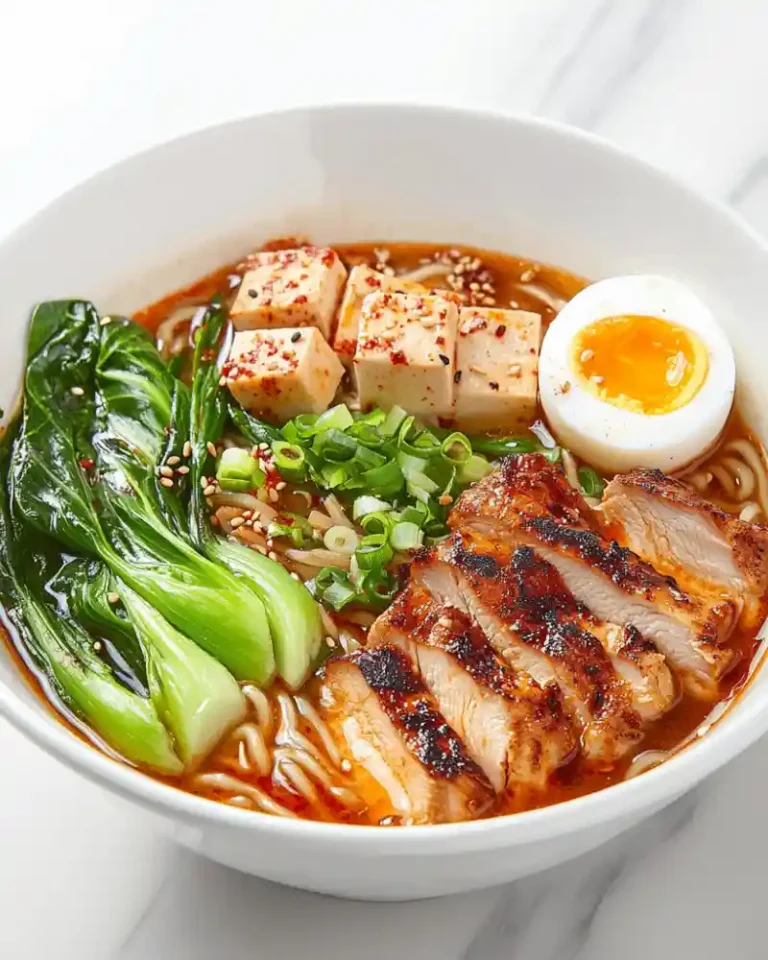If you thought ramen was off the menu because you follow a gluten-free diet—think again. Today, gluten-free ramen is not only possible, but it’s also delicious, comforting, and packed with flavor. Let’s explore how to make ramen that fits your lifestyle without sacrificing any of the slurp-worthy goodness.
Table of Contents
ToggleIntroduction to Gluten-Free Ramen
Why Gluten-Free Is More Than a Trend
Let’s be real—“gluten-free” isn’t just a buzzword anymore. Whether you’re living with celiac disease, gluten sensitivity, or just want to feel less bloated after meals, cutting gluten can offer big benefits.
The Rise of Ramen Culture Worldwide
From Japan to New York and everywhere in between, ramen has become a culinary phenomenon. But traditional ramen is built on wheat noodles—something you need to avoid if you’re gluten-free. Thankfully, alternatives have come a long way.
What Makes Traditional Ramen Not Gluten-Free?
The Wheat Factor
The main culprit is the noodles. Classic ramen noodles are made from wheat flour, which contains gluten.
Hidden Gluten in Ramen Toppings and Broth
Even if you switch the noodles, the broth can still sneak in some gluten. Soy sauce (often made with wheat), miso paste, or certain flavor packets in instant ramen can contain gluten too.
Health Benefits of Choosing Gluten-Free Ramen
Reduced Bloating and Improved Digestion
A bowl of ramen shouldn’t make you feel like you swallowed a balloon. Gluten-free options are easier on the gut and can help reduce that heavy, bloated feeling.
Celiac Disease and Gluten Sensitivity
For those considering a gluten-free diet, including options like gluten-free ramen, it’s important to understand the potential health benefits. While gluten-free diets are essential for individuals with celiac disease or gluten sensitivity, research suggests that for those without these conditions, there may be limited health advantages. Some studies have indicated that eliminating gluten can help people with sensitivities feel more energetic and less fatigued. However, gluten-free processed foods can sometimes be more expensive and may not always provide superior nutritional benefits. It’s crucial to maintain a balanced diet rich in fruits, vegetables, lean proteins, and whole grains, regardless of gluten consumption. For more insights on the gluten-free diet, check out this Healthline article.
Choosing the Right Gluten-Free Noodles
Rice Noodles
These are easy to find, affordable, and hold up well in hot broth.
Buckwheat (100% Soba)
Watch the label! Many soba noodles are mixed with wheat. Choose 100% buckwheat for a hearty, earthy bite.
Quinoa and Millet Blends
These are packed with protein and fiber and offer a more toothsome texture than plain rice noodles.
Shirataki Noodles (Low-Carb Option)
Made from konjac root, they’re almost calorie-free and a great option if you’re watching carbs.
Best Gluten-Free Broth Bases
Miso Broth (Check for Gluten-Free Label)
Some miso pastes include barley, so double-check the label.
Bone Broth for a Protein Boost
Bone broth is rich, flavorful, and naturally gluten-free. Plus, it’s loaded with collagen.
Vegan Broth with Kombu and Mushrooms
This one’s for the plant-based foodies! It’s savory, clean, and nourishing.
Delicious Gluten-Free Ramen Toppings
Protein Options: Chicken, Tofu, Tempeh
Choose grilled chicken or seared tofu for a protein punch.
Veggies that Add Flavor and Texture
Think mushrooms, bok choy, shredded carrots, and green onions.
Soft-Boiled Eggs and Gluten-Free Sauces
A ramen egg adds richness. Just use gluten-free tamari instead of soy sauce.
Making Homemade Gluten-Free Ramen
Step-by-Step Recipe
Ingredients List:
- Gluten-free noodles (rice, soba, or quinoa)
- Bone or miso broth
- Chopped spinach or bok choy
- Gluten-free tamari or miso paste
- Garlic, ginger
- Eggs (optional)
- Tofu or chicken
- Sliced green onions, sesame seeds

Instructions:
- Boil your noodles according to the package.
- Simmer broth with garlic, ginger, and tamari in a separate pot.
- Add protein and veggies.
- Combine noodles with broth and toppings.
- Garnish and slurp away!
Pro Tips for Success
- Always rinse rice noodles after boiling.
- Taste the broth before assembling—flavor is key!
- Add chili oil for a spicy kick.
Store-Bought Gluten-Free Ramen Brands to Try
Top Recommended Brands
- Lotus Foods Rice Ramen
- Mr. Lee’s Noodles
- Ocean’s Halo
- King Soba
What to Look for on Labels
Choose products labeled “certified gluten-free” and avoid unclear terms such as “natural flavors.”
Dining Out with Gluten-Free Ramen
Questions to Ask Your Server
- Are the noodles 100% gluten-free?
- Do you use wheat-based soy sauce in the broth?
- Can you substitute tamari?
Spotting Hidden Gluten in Restaurant Dishes
Be cautious with tempura toppings, imitation crab, or pre-marinated meats.
Budget-Friendly Gluten-Free Ramen Tips
- Buy noodles in bulk online.
- Make your own broth—it’s cheaper and healthier.
- Freeze portions for easy future meals.
Gluten-Free Ramen for Kids
- Use fun-shaped noodles or cut veggies into stars.
- Go light on the spice and heavy on the color.
- Let them help pick toppings!
Meal Prep and Storage Tips
- Store broth and noodles separately to prevent mushiness.
- Reheat gently to avoid overcooking.
- Freeze broth in ice cube trays for quick flavor boosts.
Common Mistakes to Avoid
- Forgetting to check all labels.
- Overcooking gluten-free noodles (they turn to mush fast).
- Skimping on seasoning—go bold!

Gluten Free Ramen
Ingredients
For the broth:
- 4 cups low-sodium chicken broth gluten-free
- 2 cups water
- 2 tablespoons gluten-free soy sauce or tamari
- 1 tablespoon miso paste optional, for umami
- 1 tablespoon sesame oil
- 1 teaspoon grated fresh ginger
- 2 garlic cloves minced
- 1 teaspoon chili oil optional, for spice
For the toppings:
- 1 cup grilled chicken breast sliced
- 1/2 cup firm tofu cubed and pan-seared
- 2 soft-boiled eggs halved
- 1 cup baby bok choy halved
- 1/2 cup green onions sliced
- 1 tablespoon sesame seeds
- Chili oil for drizzling optional
For the noodles:
- 6 oz gluten-free rice ramen noodles or rice noodles
Instructions
Prepare the Broth
- In a medium pot, heat sesame oil over medium heat. Add minced garlic and grated ginger, sauté for 1-2 minutes until fragrant. Pour in the chicken broth and water. Stir in gluten-free soy sauce and miso paste. Bring to a gentle simmer and let it cook for 10–15 minutes to allow the flavors to meld. Add chili oil if you like some heat.
Cook the Eggs
- While the broth simmers, bring a small pot of water to a boil. Carefully lower in the eggs and boil for 6-7 minutes for soft-boiled. Transfer to an ice bath, then peel and set aside.
Prepare the Toppings
- Grill or pan-sear the chicken breast until fully cooked, then slice it thinly.
- Sear the tofu cubes until golden on all sides.
- Quickly blanch bok choy in boiling water for 1-2 minutes until tender-crisp, then set aside.
Cook the Noodles
- Cook the gluten-free ramen noodles according to the package instructions. Drain and rinse with warm water to remove excess starch and keep them from sticking.
Assemble the Bowls
- Divide the cooked noodles between two white bowls. Pour the hot broth over the noodles. Arrange grilled chicken slices, seared tofu, bok choy, and halved soft-boiled eggs on top. Garnish with sliced green onions, sesame seeds, and a drizzle of chili oil if desired.
Serving Suggestions
- Serve hot and fresh with optional extra toppings like seaweed sheets, corn, or bean sprouts for added texture and variety.
Video
Notes
- Calories: 450 kcal
- Fat: 18g
- Saturated Fat: 4g
- Cholesterol: 125mg
- Sodium: 950mg
- Carbohydrates: 44g
- Fiber: 3g
- Sugars: 6g
- Protein: 29g
- Vitamin A: 35% DV
- Vitamin C: 20% DV
- Calcium: 8% DV
- Iron: 15% DV
More Gluten-Free Recipes You’ll Love:
Conclusion
Gluten-free ramen is here to stay—and it’s easier, tastier, and more satisfying than ever. With the right noodles, broth, and toppings, you can build a bowl that rivals any ramen shop, without the gluten. Whether you’re cooking at home or scouting the best brands, you’re fully equipped to enjoy a steaming bowl of delicious, slurp-worthy ramen. So go ahead, grab your chopsticks, and dig in!
FAQs
Can ramen be gluten-free?
Absolutely! Just swap traditional wheat noodles for gluten-free versions and check the broth ingredients.
Are soba noodles safe for a gluten-free diet?
Only if they’re made from 100% buckwheat—always check the label.
How do I thicken my ramen broth without flour?
Use cornstarch, mashed veggies, or let it simmer to reduce naturally.
What’s the best gluten-free ramen brand?
Lotus Foods is a fan favorite, but explore options like King Soba and Ocean’s Halo too.
Can I freeze homemade gluten-free ramen?
Yes, but freeze noodles and broth separately for best texture when reheated.





